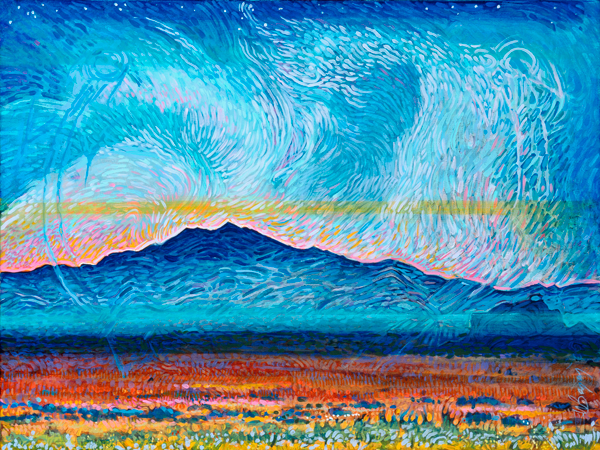
Born on a Navajo reservation, Shonto Begay has been painting for over 30 years and is represented in galleries across the Southwest. In addition to his paintings, Begay has worked as a children’s book author and illustrator, an educator, an actor, and a National Park Service ranger.
“I grew up in the traditional Navajo lifestyle, camping year round. I spent a lot of time alone as a shepherd and those times alone were the times that changed my eyes, my senses. Just watching the world, watching the goats, keeping them away from the cornfield. And of course, later on that translated into trying to copy nature. Anything that could receive a mark, an old cardboard, even slip rocks, anything like that. So I began trying to copy my world.
I was forced into the U.S. government boarding school system. It was a brutal institution, and it was in those times—times of hardship—that I learned to escape the harsh reality by drawing on the margins of my homework. Just drawing, just living in my own constructed universe. That’s how I survived boarding school, that’s how I am still surviving today. It was just a way of staying alive.
I’ve always seen my artwork as a ceremony. In the Navajo tradition, we are very aware about the little subtleties of the spirit around us. In the healing ceremonies, there was a lot of praying, a lot of chants. It was beautiful and powerful and rhythmic and poetic. [In my paintings], the little broken lines and swirls and curls and dots are my own alphabet. I see it as a script to the universe spirit world. Each one of these broken lines and dots, I see them as a syllable to words, words to sentences, sentences to paragraphs, and so on. So it’s kind of like my own visual chant.
We are just surrounded by beauty. I live in Northern Arizona and of course the canyons, the mountains, the mesas, the sprawling landscapes—it’s where I find my refuge and refueling. When a Navajo child is born, the umbilical cord is buried in the ground. In this manner, you can be taken out of the land but it will never be taken out of you; the land is always a part of you. That’s how I see the landscape. It’s the echo chamber of my universe inside.”

